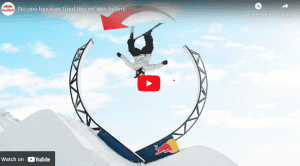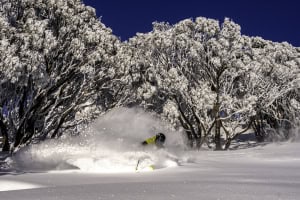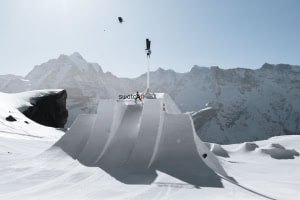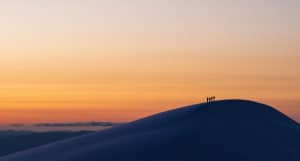Skiing Blue Lake Australia – Spring 2009

The steep faces of The Amphitheatre above Blue Lake is visible for most of the walk from Charlotte Pass.
Story and photos by Chris Booth
In a country that is known for never-ending desert tundra, unearthly red rocks and mango-flavoured ice cream, skiing a giant alpine range is quite novel, and for most that is enough. But what most people don’t realise is that if you know where to go, the skiing is actually brilliant. You see, most people presume that to ski down anything good in Australia you have to venture out to the western faces, camp overnight, brave the wind and cold, eat boiled granola and hike hours for each run. This presumption is wrong.
The Western Faces provide the most dramatic terrain in Australia, hands down. But the chief problem is implied in their name – they face west. Everyone knows that a west-facing slope either has no snow on it, or is blown to pieces. In truth however, there do exist some aspects out there that do not face directly west and that do accumulate snow, but for reasons expressed in the paragraph above it is still not worth it, at least to me.
Blue Lake, Club Lake and South Ramshead peak all face east. They are leeward slopes – which means that our real winter storms (which emanate from the south-west) hit the western faces while snow accumulates on the other side – filling-in those areas nicely. These aspects are good to go, powdery after a winter storm and plentiful throughout the spring.
Further, they are much easier to access, making the trip easy to accomplish within a single day. After a long day’s backcountry skiing I would much prefer to be in Charlottes Pass Pub sipping ice-cold pale ale than in a tent somewhere up on Mt Twynam sucking frosty cordial from a camelbak.
Getting to Blue Lake
Our crew of Andrea Berchtold, Simon Blondell, Western Deutschlander, Luke Flynn and myself chose to ski Blue Lake late in the spring. Spring season provides optimal conditions for hiking, with stable warm weather friendly to hikers. Ironically, unseasonal winter storms had rolled through the alps the week before, making the backcountry look more like mid-July.
Departing from the Charlottes Pass turning circle (the beginning of the Kosciusko trail), we unloaded our gear from the Perisher-Charlottes snow shuttle and headed for Blue Lake – which is visible from the viewing platform. We descended down to the first river, stripped down, crossed the icy knee-deep water then made the 3km hike out to Blue Lake.
Of course, as Murphy would have it, the fog rolled in just as we arrived, the white-out forcing us to wait over an hour before we could actually catch sight of the face we wanted to ski. The unstoppable progress of the clock was against us, the longer we waited, the less time we had to ski. On top of this, the shade creeps onto the slope of Blue Lake very quickly, and with each passing minute we could see the ominous silhouette of the cornice stretch down the face. On the positive side, this gave me ample time to enjoy the delicious sandwiches I had made.

Crossing the river in the wrong spot means pants off wading.

The author Chris Booth wades across the river while Andrea Berchtold looks on.
Skiing the Blue Lake Amphitheatre
Finally, and prodigally, it cleared. Blue Lake revealed itself in breathtaking fashion, with its deep, dramatic couloirs and almost vertical pitch. The group picked out lines and began the skin up – which is quick and easy considering you can just walk around the side and arrive at the top in under 20 minutes.
Once at the top, we had to be extremely careful walking above the cornices, never forgetting that teetering too close to the edge could have fatal consequences. (A skier died there last year after the cornice collapsed beneath him.) Read the newspaper article here.
Western found a solid entry point where the snow had built up underneath the cornice, stabilizing it. A look behind us highlighted the obvious risk, with crown-fractures underneath every cornice on the main range and considerable slides paths running in excess of 100 metres. Still the snow seemed to have set up nicely and looked safe to go – not that you ever really know. Then after scoping our lines from the top, we dropped in.
Andrea took a creative line down the skiers left while Simon, unafraid, took on a nasty entrance to the deep couloir on the skiers right, leaving Western and myself to ski the fall line off the cornice. The snow was variable and unpredictable, but what a buzz it was. The terrain there is perfect for riding, there are plenty of lines to choose from, and myriad features to launch off (if that’s your thing).
The mere fact of skiing big mountain terrain in Australia is of itself something thing fills you up with a sense of pride in this country. So, despite having only had the time to make one run (due to our late start hiking) an unshakeable feeling of deep satisfaction permeated the group as we ambled back toward civilization. Albeit on tired legs.
Having had a small taste of skiing Blue Lake, I can’t wait to return. In fact I’ve already chosen my line for next year.

Pick your line and remember it. You’ll need the memory from the top as it never looks the same.

Andrea Berchtold and Chris booth stand on top of the Amphitheatre miniaturised by the huge cornices.

Dropping into the Amphitheatre takes both committment and skill to find a safe line away from the dangerous cornices. A skier was killed her in 2008.

Andrea Berchtold taking his line down the skiers left of Blue Lake Amphitheatre.

Chris Booth laying over a critical turn above exposure in the middle of the Blue Lake Amphitheatre.

Western Deutschlander skiing the tight chute into stag gully. Look closely and you’ll see him.

Crossing the river on the home. Taking the correct crossing means you can keep your daks on.

Looking towards Club Lake reveals more opportunities for those willing to make the walk.

The Australian Spring snow pack was deep with continual storms. This photo taken on the way to Charlotte Pass.






